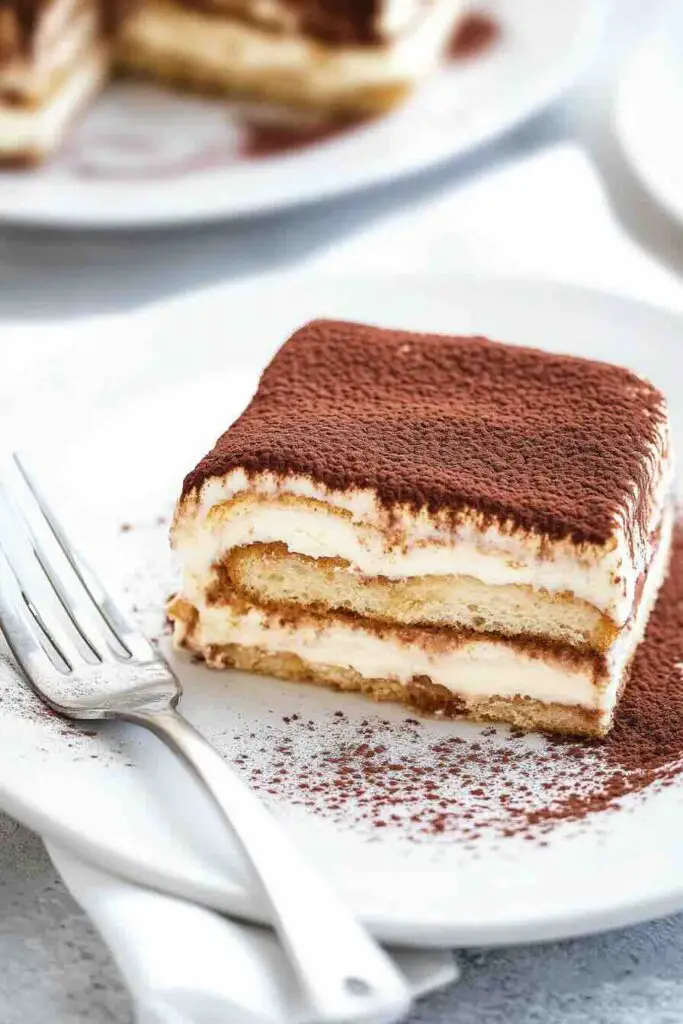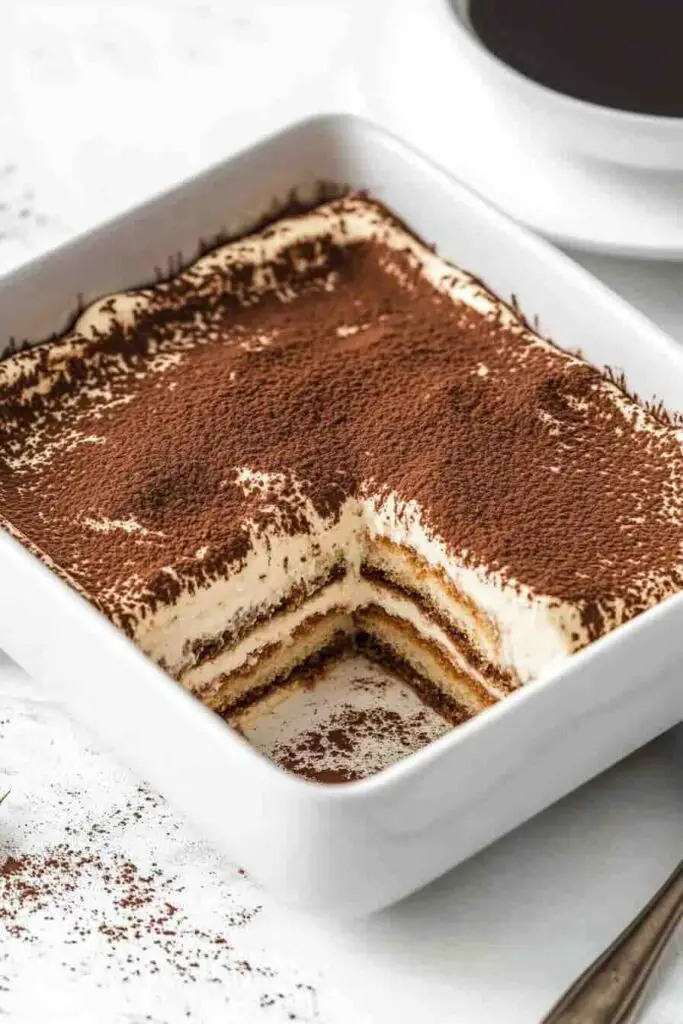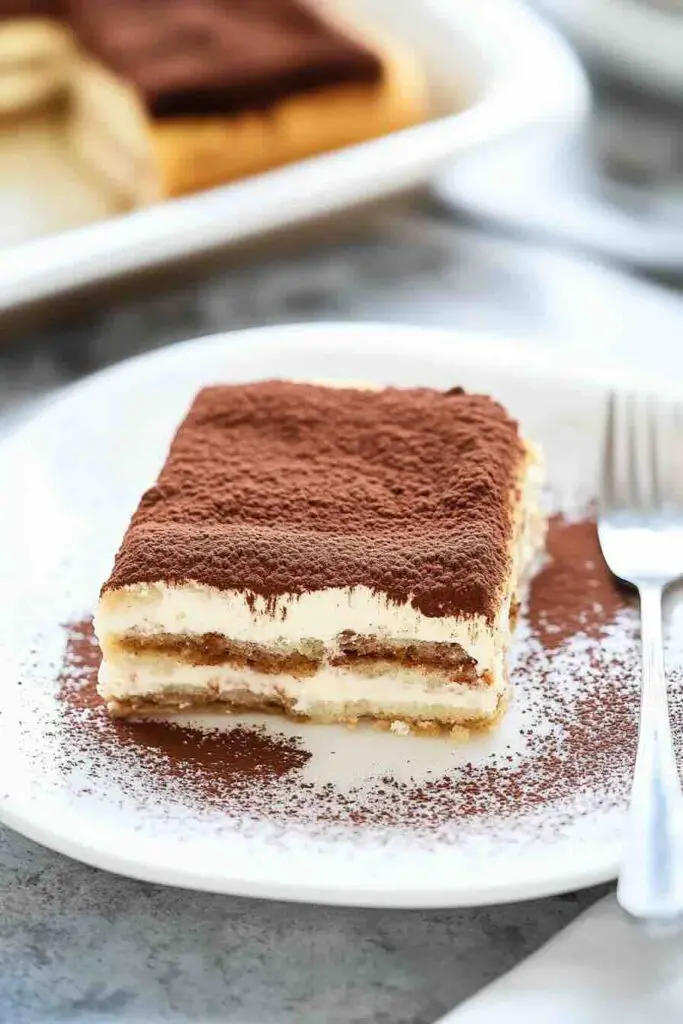Introduction
Oh wow, if you’ve ever wanted to make tiramisu but hesitated because of the raw eggs, you’re in for a treat! This classic tiramisu without eggs is everything you love about the traditional Italian dessert—creamy, coffee-infused, and utterly irresistible—but without the eggs.
I get it. Raw eggs in desserts can be a bit intimidating. Maybe you’re worried about food safety, or you just don’t love the texture they create. Either way, this egg-free version solves that problem without sacrificing any of the rich flavor or luscious texture. In fact, some might argue it’s even BETTER than the classic because it’s silkier, lighter, and easier to make.
Tiramisu has a special place in Italian cuisine. Originating from the Veneto region, this iconic dessert combines the deep, aromatic notes of espresso with the velvety smoothness of mascarpone. The ladyfingers (savoiardi) act like sponges, soaking up all that coffee goodness, while a dusting of cocoa powder ties everything together with a bittersweet finish. Traditionally, tiramisu includes egg yolks in the mascarpone cream to create richness, but we’re skipping that step in favor of something even simpler: a dreamy, whipped cream and mascarpone filling.
So, why should you make this recipe? Well, for starters:
- No eggs, no problem! It’s easier and safer.
- You’ll need just 20 minutes to put it together (the hardest part is waiting for it to chill!).
- It tastes 100% authentic—creamy, coffee-soaked, and just sweet enough.
Let’s dive in and make the ultimate eggless tiramisu that’ll have you coming back for more.

Reasons You’ll Love This Recipe
Ease of Preparation
Making tiramisu doesn’t have to be complicated! With just a handful of ingredients and zero cooking required, this is one of those back-pocket desserts you’ll turn to again and again.
- Minimal ingredients – Nothing fancy here, just simple, high-quality staples.
- 20-minute prep time – Yep, that’s all it takes. Then, just pop it in the fridge and let it set.
- No special equipment – A hand mixer and a baking dish are all you need.
Authentic Italian Flavor
Even though we’re skipping the eggs, this tiramisu doesn’t skimp on authentic taste. The key? Real mascarpone, bold espresso, and a splash of Marsala wine (totally optional but highly recommended!).
- Mascarpone cheese – The heart and soul of tiramisu, lending a rich, buttery flavor.
- Fresh espresso – Because the best tiramisu starts with high-quality coffee.
- Cocoa powder – A bitter contrast that balances the sweetness beautifully.
Versatility
This recipe is super adaptable! You can easily swap ingredients to suit your dietary needs or preferences.
- Want it alcohol-free? Just use coffee alone.
- Need a vegan option? Use plant-based mascarpone and dairy-free whipped cream.
- No ladyfingers on hand? Sponge cake works as a substitute.
Impressive Presentation
If you’re looking to wow guests, this is the dessert. Those delicate layers of coffee-soaked biscuits and creamy mascarpone look effortlessly elegant. A dusting of cocoa powder on top? Pure perfection.
What Makes a Good Classic Tiramisu Without Eggs?
Clarity and Appeal
A good recipe name should tell you exactly what you’re making. Classic Tiramisu Without Eggs is straightforward yet enticing—no surprises here!
Authenticity
Even though we’re skipping the eggs, this tiramisu stays true to its Italian roots. We’re keeping the essential elements—mascarpone, coffee, and ladyfingers—while making it more accessible for everyone.
Highlighting Key Attributes
The egg-free twist is what sets this version apart, making it a fantastic option for those who want to enjoy tiramisu without any raw eggs.
Memorability
Simple, clear, and easy to remember! When you hear “eggless tiramisu,” you know exactly what to expect—creamy, dreamy goodness.
The Cultural Significance of Tiramisu
Italian Culinary Heritage
Tiramisu isn’t just a dessert—it’s a symbol of Italian hospitality. Originating in the Veneto region, this dish is a staple at family gatherings, romantic dinners, and celebrations.
Modern Adaptations
Over time, tiramisu has evolved to accommodate different dietary preferences. While the original version uses raw egg yolks, modern variations (like this one!) keep the creamy texture intact while making it more approachable.
Community Impact
This dessert is social by nature—it’s meant to be shared. Whether you’re making it for a party or just treating yourself, tiramisu always brings people together.
A Symbol of Indulgence
Tiramisu is pure comfort food. Creamy, coffee-laced, and just sweet enough—it’s indulgence at its finest.
History of Tiramisu
Origins in Italy
The exact origin of tiramisu is debated, but it’s widely believed to have been created in Treviso, Italy, in the 1960s. Some claim it was served to weary travelers for a quick energy boost, thanks to the coffee-soaked biscuits.
Traditional vs. Modern Versions
- Classic tiramisu uses raw egg yolks, mascarpone, sugar, and coffee-soaked ladyfingers.
- Modern tiramisu (like this one!) ditches the eggs, making it safer and easier to prepare.
Evolution Over Time
Over the decades, tiramisu has been adapted to suit different tastes—some versions include chocolate shavings, fruit, or even different types of liqueur.
Global Influence
From Italian trattorias to home kitchens worldwide, tiramisu has become a global favorite. Its simplicity and elegance make it one of the most beloved desserts of all time.
Ingredients To Make Classic Tiramisu Without Eggs
- 260 ml double cream (32% fat)
- 300 g mascarpone cheese
- 300 g ladyfingers (savoiardi)
- 100 g fine sugar
- 250 ml freshly brewed espresso, cooled
- 50 ml Marsala wine (optional)
- 60 g unsweetened cocoa powder
Quality matters! Fresh mascarpone and strong espresso make all the difference in flavor.
Essential Equipment
- Mixer – For whipping the cream to the perfect consistency.
- Spatula – Helps fold the mascarpone mixture without deflating it.
- 6×8 inch baking dish – The perfect size for layering.
Step-By-Step Instructions
1. Whip the Cream
- Pour double cream into a mixer and whip on low, then gradually increase speed.
- Beat for about 5 minutes until it’s fluffy and holds soft peaks.
2. Prepare the Mascarpone Cream
- In a separate bowl, mix mascarpone and sugar until smooth.
- Gently fold in the whipped cream in thirds, using a bottom-to-top motion.
3. Soak the Ladyfingers
- Combine espresso and Marsala wine (if using).
- Dip ladyfingers for 1 second per side (don’t let them get mushy!).
- Arrange them in a single layer in your dish.
4. Layer the Tiramisu
- Spread half of the mascarpone cream over the ladyfingers.
- Repeat with another layer of soaked ladyfingers and the remaining cream.
5. Chill and Serve
- Refrigerate for at least 2 hours (overnight is even better!).
- Dust generously with cocoa powder before serving.

How to Tell When Classic Tiramisu Without Eggs is Done
One of the best things about making tiramisu is that there’s no baking involved—so you don’t have to worry about setting an oven timer or checking for doneness like you would with a cake or cookies. Instead, tiramisu relies on a combination of proper layering, chilling time, and texture cues to reach its ideal consistency.
Visual Cues
A well-made tiramisu should have clean, distinct layers when you slice into it. The mascarpone cream should appear thick and smooth, sitting atop coffee-soaked ladyfingers that have softened just the right amount—moist but not falling apart. If you notice the layers blending together into a mushy mess, it’s likely that the ladyfingers were oversaturated with coffee or the tiramisu hasn’t been chilled long enough.
Texture and Consistency
When you take a bite, the cream should feel light and airy rather than runny or overly dense. The ladyfingers should have absorbed the coffee’s flavor while still maintaining a slight structure, almost like a soft sponge cake. If the mascarpone mixture seems too thin or soupy, it might need additional chilling time to firm up properly. On the other hand, if the cream is too thick or stiff, it could be due to over-whipping, which can make the mascarpone mixture grainy.
Variations & Toppings
One of the reasons tiramisu is such a beloved dessert is its versatility. While the traditional version sticks to mascarpone, coffee, and cocoa, there are plenty of ways to tweak it to fit different tastes and dietary needs. Whether you want to experiment with new flavors, swap out ingredients, or make it even more decadent, there’s no shortage of creative variations to explore.
Ingredient Substitutions
If you’re looking for alternatives to classic ladyfingers, sponge cake or angel food cake make excellent substitutes. Just be sure to slice them into even strips and dry them out slightly before dipping, so they don’t absorb too much liquid too quickly.
For those following a vegan diet, there are now egg-free and dairy-free mascarpone substitutes available, as well as vegan whipped creams that can replace traditional double cream. Additionally, some brands offer vegan ladyfingers, so you can easily create a completely plant-based tiramisu without compromising on texture or taste.
Alternative Liqueurs
While Marsala wine is a traditional choice, you can experiment with other liqueurs to change up the flavor profile. Some popular options include:
- Amaretto – Adds a nutty, almond-like sweetness.
- Coffee Liqueur (like Kahlúa) – Enhances the deep coffee flavors.
- Irish Cream (such as Baileys) – Gives a creamy, slightly caramel-like richness.
For a kid-friendly or non-alcoholic version, simply use coffee on its own or mix it with a small amount of cocoa powder for a subtle chocolatey depth.
Topping Enhancements
The final dusting of unsweetened cocoa powder is essential for that signature tiramisu look and taste, but there are plenty of other ways to add extra flair:
- Chocolate shavings – Use a vegetable peeler to create delicate curls of dark or milk chocolate.
- Cocoa-dusted coffee beans – Aesthetic and aromatic!
- Powdered sugar – Lightly sprinkled for a slightly sweeter finish.
For a seasonal twist, try adding a hint of pumpkin spice in the fall or a sprinkle of cinnamon during the winter holidays.
Nutritional Insights
Tiramisu may be a decadent treat, but that doesn’t mean you can’t enjoy it while keeping an eye on nutrition. While this dessert leans toward the indulgent side, understanding its nutritional breakdown can help with portion control and ingredient swaps for a lighter version.
Caloric Information
A standard serving of tiramisu (about 150g) typically contains around 496 calories. This number can vary depending on ingredient choices, portion sizes, and whether additional toppings or liqueurs are included.
Macronutrient Breakdown
- Carbohydrates: Approximately 42g – Mainly from the sugar and ladyfingers.
- Protein: Around 9g – Primarily from mascarpone and cream.
- Fat: Roughly 33g, with 20g being saturated fat from the mascarpone and cream.
Micronutrients
Despite being a dessert, tiramisu does offer small amounts of Vitamin A, calcium, and iron, thanks to the dairy content. However, it’s not a significant source of vitamins or minerals, so it’s best enjoyed in moderation.
Health Considerations
If you’re looking for ways to lighten up the recipe, consider:
- Using low-fat mascarpone or a blend of mascarpone and Greek yogurt.
- Reducing sugar slightly—especially if your coffee and cocoa powder already have some natural bitterness.
- Cutting back on the amount of whipped cream to decrease the fat content.
Pro Tips & Tricks
Maintaining Whipped Cream Fluffiness
To ensure your whipped cream stays airy, always use cold cream straight from the fridge. If your kitchen is warm, you can even chill the mixing bowl and whisk beforehand—this helps create the best volume and texture.
Preventing Sogginess
The trick to keeping your ladyfingers from getting too soft is dipping them quickly—just one second per side in the espresso is enough. If they absorb too much liquid, they can lose structure and turn mushy.
Troubleshooting Texture Issues
If your mascarpone mixture turns too runny, it might be due to over-mixing or using mascarpone that was too warm. To fix it, refrigerate the mixture for about 30 minutes before layering.
If the tiramisu turns out too firm after chilling, let it sit at room temperature for 10–15 minutes before serving.
My Take on Classic Tiramisu Without Eggs
I’ll admit—I was skeptical about making tiramisu without eggs at first. Would it still be rich enough? Would it taste authentic? But after testing this recipe multiple times, I can confidently say that this egg-free tiramisu is a game-changer.
I personally love how light and creamy this version is compared to traditional tiramisu. The mascarpone and whipped cream create a silky-smooth texture without feeling too dense. Plus, it’s just easier—no fussing over raw eggs or worrying about tempering them correctly.
One of my favorite things about this recipe is how versatile it is. Whether I’m making it for a dinner party or just craving something sweet, it always hits the spot.

Storage & Health Tips
Proper Storage Methods
Tiramisu must be refrigerated to keep its texture intact. After assembling, cover it with plastic wrap or an airtight lid and store it in the fridge for up to 2 days.
If you want to freeze tiramisu, wrap it tightly and store it for up to 1 month. Before serving, let it thaw in the fridge overnight.
Safety Tips
Because this recipe contains dairy, it’s important to keep it chilled until serving. Leaving it out for too long can cause the mascarpone to break down or spoil.
FAQs About Classic Tiramisu Without Eggs
Can tiramisu be made without eggs?
Absolutely! Instead of eggs, this recipe relies on whipped cream to create that signature creamy texture.
What is in traditional tiramisu?
Classic tiramisu typically contains ladyfingers, mascarpone, eggs, sugar, espresso, Marsala wine, and cocoa powder.
How long does tiramisu last without eggs?
Stored properly in the fridge, it stays fresh for 1–2 days.
Can I make it in advance?
Yes! In fact, tiramisu tastes even better the next day, as the flavors meld together beautifully.
Before You Go…
Craving more goodness? Check out my recipe for Tiramisu With Eggs next. It’s just as comforting, indulgent, and easy to make. You’re going to love it! ❤️
Print
Tiramisu Recipe Without Eggs
- Prep Time: 20 minutes
- Cook Time: 0 minutes (no baking required)
- Total Time: 2 hours 20 minutes (including chilling)
- Yield: 6 servings 1x
Description
This Classic Tiramisu Without Eggs is a dreamy, creamy, and utterly delicious Italian dessert! Made with layers of espresso-soaked ladyfingers and a luscious mascarpone-cream mixture, it delivers all the indulgence of traditional tiramisu—without raw eggs. The best part? It takes just 20 minutes of prep and is a perfect make-ahead dessert for gatherings, date nights, or a sweet treat anytime.
Ingredients
- 260 ml double cream (32% fat)
- 300 g fresh mascarpone cheese
- 300 g ladyfingers (savoiardi)
- 100 g fine sugar
- 250 ml freshly brewed espresso coffee, cooled
- 50 ml Marsala wine (optional)
- 60 g unsweetened cocoa powder
Instructions
-
Whip the Cream:
- In a mixing bowl, whip cold double cream on low speed, gradually increasing to medium.
- Beat for about 5 minutes until thick, fluffy peaks form. Set aside in the fridge.
- Prepare the Mascarpone Cream:
- In another bowl, blend mascarpone cheese and sugar on low speed for 3 minutes.
- Gently fold in the whipped cream in three batches using a spatula, ensuring a light, airy texture.
-
Dip the Ladyfingers:
- Mix cooled espresso with Marsala wine (if using).
- Quickly dip each ladyfinger for 1 second per side—do not oversoak!
- Arrange a single layer in a 6×8-inch dish, breaking them if needed.
-
Assemble the Tiramisu:
- Spread half of the mascarpone mixture over the ladyfingers.
- Repeat with a second layer of dipped ladyfingers, followed by the remaining mascarpone cream.
-
Chill & Finish:
- Cover and refrigerate for at least 2 hours (overnight is best for flavor).
- Before serving, dust with cocoa powder and enjoy!
Notes
- Use high-quality mascarpone for the creamiest texture.
- To make it alcohol-free, replace Marsala wine with more coffee or milk.
- Tiramisu tastes even better the next day, so it’s great for making ahead!
- Store in the fridge for up to 2 days or freeze for up to a month.
Nutrition
- Calories: 496
- Sugar: 22g
- Sodium: 60mg
- Fat: 33g
- Saturated Fat: 20g
- Carbohydrates: 42g
- Fiber: 2g
- Protein: 9g
- Cholesterol: 120mg
